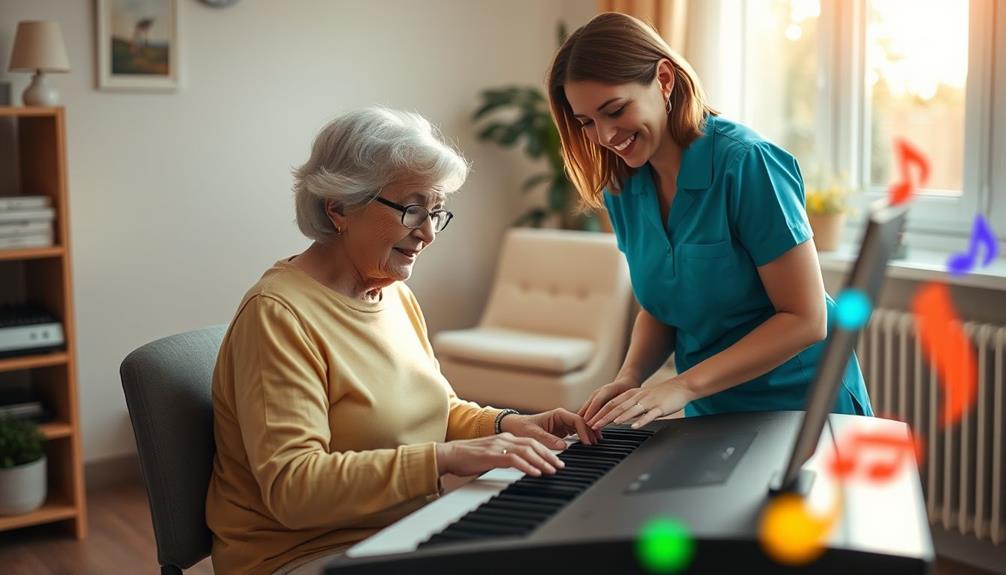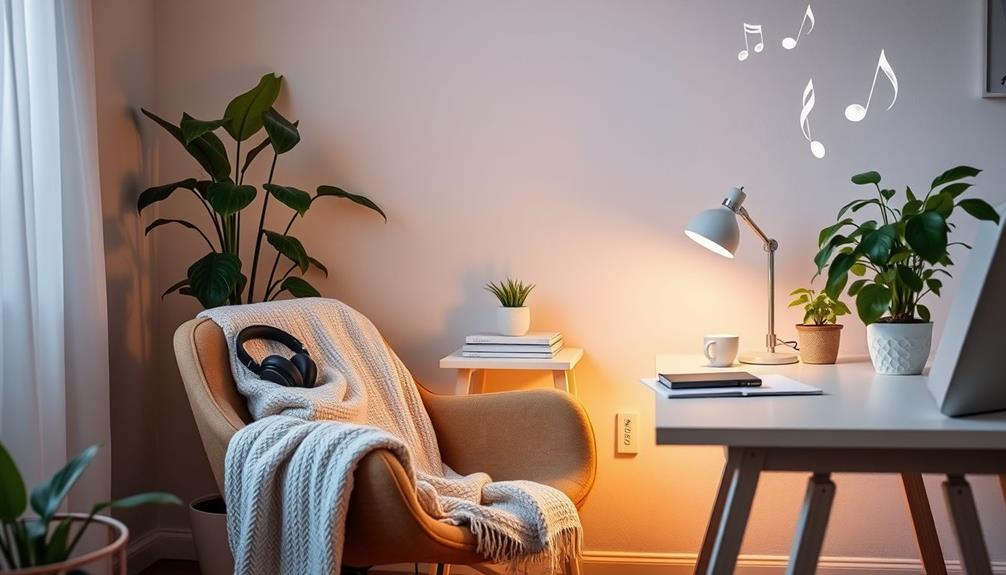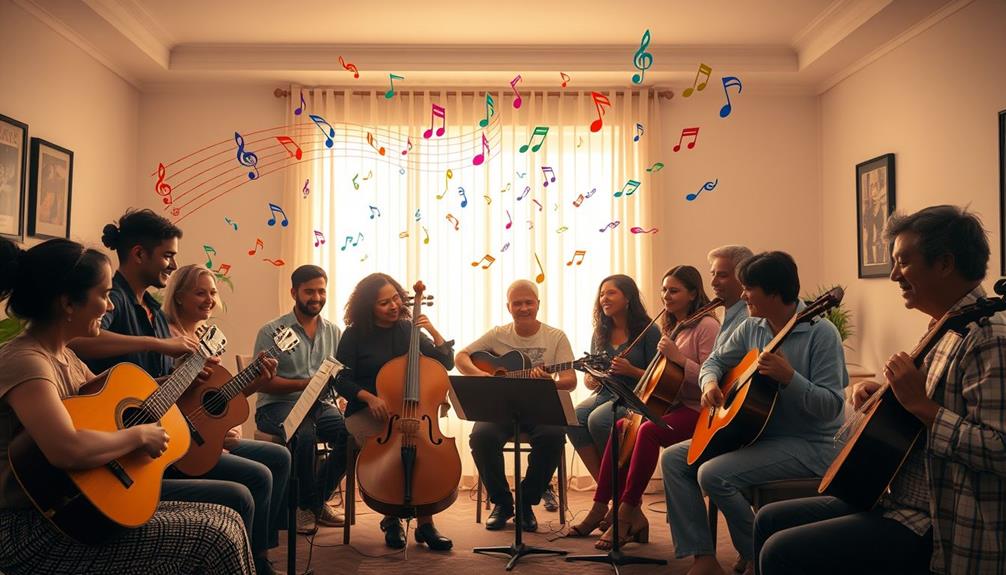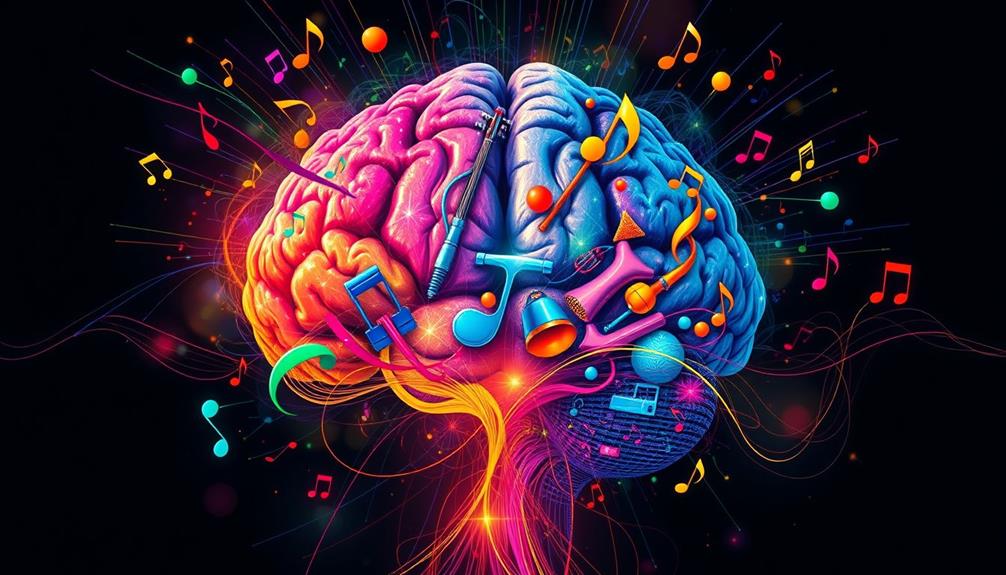Music therapy can be a game-changer for stroke patients like you, boosting recovery in several ways. It enhances emotional well-being, reduces feelings of isolation, and improves cognitive function, such as memory and attention. You'll find that engaging in music therapy also aids motor skills through techniques like rhythmic stimulation, helping regain movement and coordination. Plus, it supports speech recovery, particularly for those with aphasia, by tapping into preserved communication abilities. By integrating music therapy into your rehabilitation plan, you can enjoy a more holistic approach to recovery. Curious about how it all works? There's more to explore.
Key Takeaways
- Music therapy enhances recovery by improving motor function, speech, and cognitive abilities in stroke patients through engaging therapeutic techniques.
- Techniques like Melodic Intonation Therapy and Rhythmic Auditory Stimulation facilitate communication and motor coordination, aiding rehabilitation efforts.
- Over 70% of stroke survivors report improved mood and emotional well-being through participation in music therapy sessions.
- Music therapy effectively addresses dysphagia, enhancing speech motor coordination and swallowing abilities, leading to better quality of life.
- Community-based music initiatives, such as aphasia choirs, foster social connections and combat feelings of isolation among stroke patients.
Overview of Stroke Rehabilitation
Stroke rehabilitation is vital for helping you regain lost functions and improve your quality of life after a stroke. Each year, millions suffer from strokes, resulting in significant rehabilitation needs to restore motor and cognitive functions.
Early rehabilitation plays an important role in your recovery, as it can greatly enhance outcomes and address complications like dysphagia and aphasia. Incorporating somatic therapy techniques into your rehabilitation plan can complement music therapy, as it focuses on the mind-body connection which is beneficial for emotional and physical healing.
Incorporating music therapy into your rehabilitation plan can be a game-changer. It has been shown to effectively tackle motor function deficits, cognitive impairment, and emotional issues.
Clinical evidence suggests that around 70% of stroke survivors experience improved mood and cognitive function through music therapy. Studies indicate that using music therapy techniques can lead to up to a 40% increase in recovery rates for motor skills.
To optimize treatment protocols, it's important to rely on strong clinical evidence, which highlights the need for more randomized controlled trials to validate the efficacy of music therapy in stroke rehabilitation.
Understanding Music Therapy
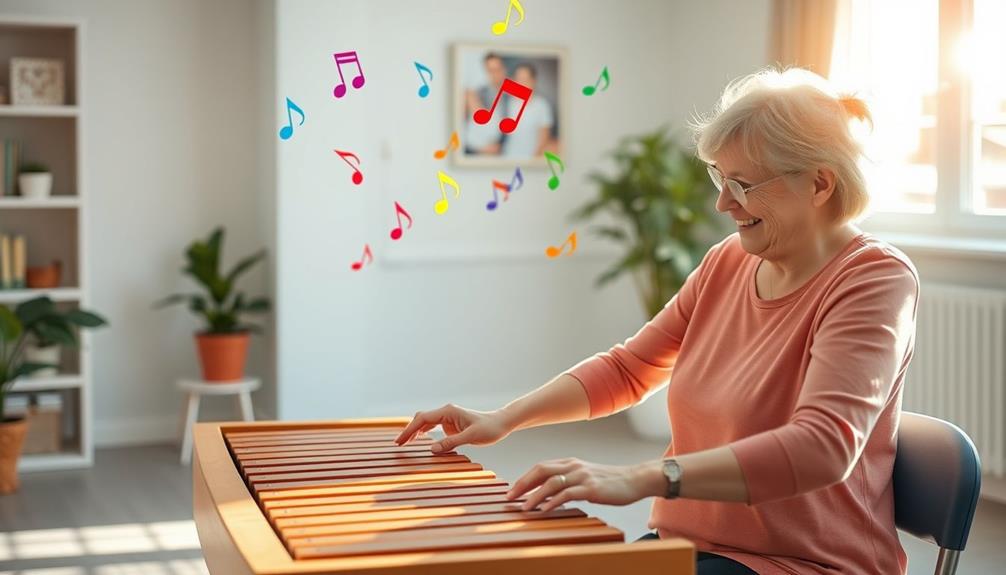
Music therapy is a powerful tool that uses music to help you overcome the challenges posed by a stroke. By employing various therapeutic techniques, it addresses deficits in motor skills, speech, and cognitive functions.
Additionally, AI-generated music is being explored in therapeutic settings, providing innovative ways to engage patients. Understanding how these methods work can enhance your recovery journey and improve your quality of life.
Definition of Music Therapy
Utilizing music as a therapeutic tool, music therapy addresses the diverse physical, emotional, cognitive, and social needs of patients, especially those recovering from a stroke. This therapeutic intervention plays an essential role in rehabilitation for stroke survivors by incorporating techniques like singing, listening to music, and playing instruments.
These activities help improve motor function, with studies showing enhancements of up to 40%, and boost speech abilities in over 60% of patients. In addition, the emotional benefits of music therapy can help individuals process trauma and emotional pain, much like the way understanding narcissistic traits can aid in personal healing.
Music therapy engages multiple brain areas linked to language, attention, and emotion, promoting neuroplasticity and facilitating structural changes in the brain following a stroke. This means that your brain can rewire itself, improving recovery outcomes.
Moreover, music therapy notably contributes to your emotional well-being, allowing you to express feelings that might be difficult to articulate otherwise.
Recognized as a cost-effective and patient-accepted method, music therapy complements traditional rehabilitation approaches, making it a valuable asset in stroke recovery. By focusing on your unique needs, this intervention fosters a supportive environment that enhances your overall quality of life.
Therapeutic Techniques Overview
Understanding the various therapeutic techniques used in music therapy is essential for recognizing how they specifically aid stroke recovery. One key approach is Melodic Intonation Therapy (MIT), which uses rhythm and melody to improve communication and naming abilities for those with aphasia. This technique can greatly boost your ability to express yourself.
Additionally, engaging in crazy games alongside music therapy can foster teamwork and social interaction, which are beneficial for emotional recovery. Another method, Rhythmic Auditory Stimulation (RAS), helps enhance motor function by synchronizing your movements with musical rhythms, leading to improvements in walking speed and stride length.
For upper-limb rehabilitation, music-supported therapy (MST) has shown great success, enhancing motor function and coordination through structured musical interventions. Beyond physical rehabilitation, engaging in music therapy promotes emotional well-being and cognitive recovery. Listening to music can elevate your mood and improve cognitive functions like memory and attention.
Additionally, participating in group music therapy activities, such as choirs, fosters social connections among stroke survivors. This sense of community reduces feelings of isolation and greatly improves overall emotional health.
Music Therapy and Dysphagia
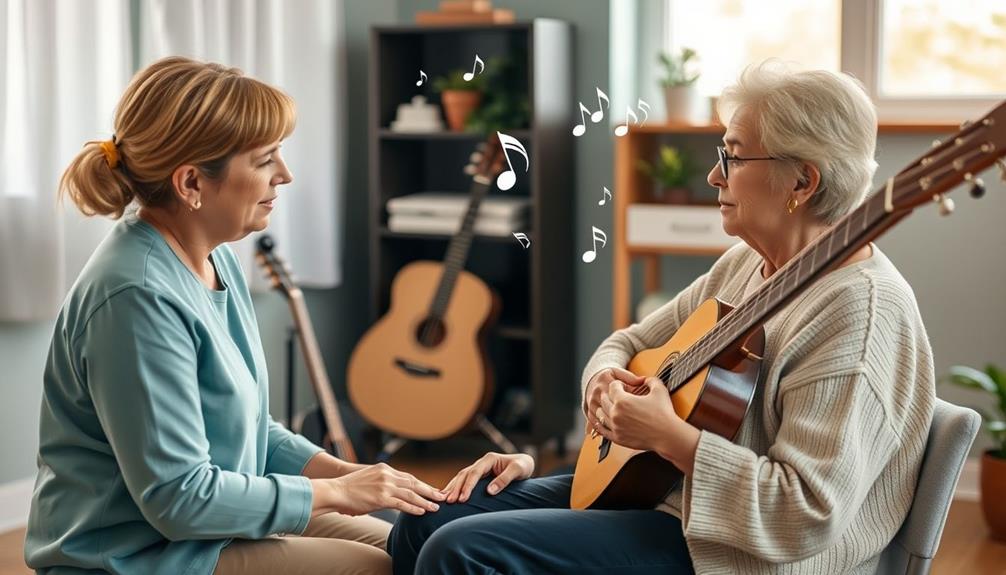
For many stroke patients, dysphagia presents a vital hurdle in recovery, affecting their ability to swallow safely and efficiently. This condition impacts 28%-67% of stroke survivors, leading to complications like aspiration pneumonia and malnutrition. For many stroke patients, dysphagia presents a vital hurdle in recovery, affecting their ability to swallow safely and efficiently. This condition impacts 28%-67% of stroke survivors, leading to complications like aspiration pneumonia and malnutrition. Effective management often involves dietary modifications, swallowing therapy, and, in severe cases, feeding tube interventions to prevent further health deterioration. While advancements in treatment offer hope, unrelated headlines such as the “diddy combs lawsuit update” often dominate the public sphere, overshadowing conversations about these critical medical challenges. Raising awareness of conditions like dysphagia is crucial to improving resources and support for stroke survivors.
Thankfully, music therapy offers a promising approach to alleviate dysphagia symptoms and enhance swallowing functions. Additionally, hydration strategies can play an essential role in supporting overall recovery and metabolism during the rehabilitation process.
Here are a few key benefits of music therapy in this regard:
- Improves Speech Motor Coordination: Clinical studies show that music therapy sessions can enhance the coordination necessary for effective swallowing.
- Utilizes Music-Enhanced Swallowing Protocols: These targeted techniques have been shown to improve oral motor control, which is essential for safe swallowing.
- Facilitates Rehabilitation: Engaging with music not only aids in swallowing recovery but also fosters overall rehabilitation efforts.
- Enhances Quality of Life: By improving swallowing abilities, music therapy can greatly boost the quality of life for stroke survivors dealing with dysphagia.
Incorporating music therapy into your recovery plan can lead to positive outcomes, making it a valuable tool for addressing dysphagia among stroke patients.
Enhancing Motor Function Recovery

Many stroke patients find that music therapy plays an essential role in enhancing their motor function recovery. By integrating rhythmic auditory stimulation into rehabilitation, you can experience significant improvements in both gait and upper-limb motor function. Studies show that incorporating music interventions can lead to better walking speed and stride length, making daily activities more manageable.
| Aspect | Benefit | Outcome |
|---|---|---|
| Gait Training | Improves walking performance | Enhanced mobility |
| Upper-Limb Motor Function | Increases independence in daily tasks | Greater functionality |
| Overall Recovery Outcomes | Boosts rehabilitation effectiveness | Improved quality of life |
For chronic hemiparetic stroke patients, intensive gait training paired with rhythmic auditory stimulation has shown promising results. This combination highlights the therapeutic potential of music therapy in your recovery journey. As an elderly stroke patient, you may also find that these music interventions positively impact your overall motor rehabilitation, leading to enhanced recovery outcomes. Embracing music therapy could be a crucial step toward regaining your independence.
Addressing Cognitive Impairments
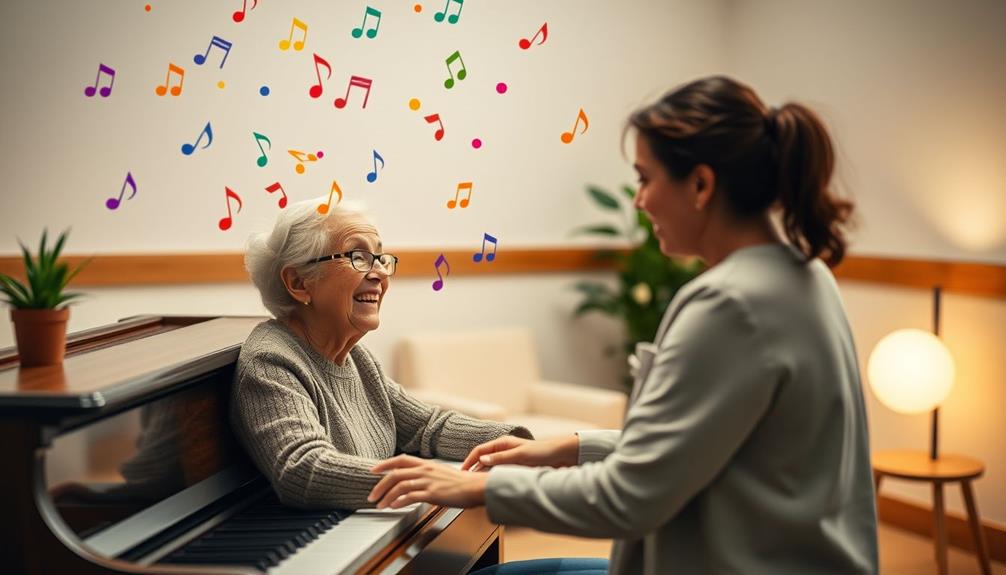
Cognitive impairments after a stroke can greatly impact your daily life, but music therapy provides a promising avenue for recovery. Engaging in music therapy enhances cognitive functions like memory and attention, promoting long-term neural plasticity.
Additionally, the use of ethical considerations in AI applications is essential in exploring innovative therapeutic methods that prioritize patient well-being.
Here are some key benefits you can expect:
- Improved Communication Abilities: Music therapy helps stroke patients regain lost communication skills, particularly in those with aphasia.
- Enhanced Speech Production: Techniques like Melodic Intonation Therapy (MIT) utilize singing to improve speech and language recovery.
- Stimulated Brain Activity: Listening to music activates brain areas tied to memory and language, facilitating both cognitive and emotional recovery.
- Increased Emotional Well-Being: The therapeutic effects of music can lift your mood, helping you cope with the emotional aspects of stroke recovery.
Research supports that over 60% of stroke patients involved in music interventions show significant improvements in their speech abilities.
Music Therapy for Aphasia

If you or someone you know is dealing with aphasia after a stroke, music therapy could be a game-changer.
Studies indicate that emotional connections, similar to those observed in feline behavior, can be fostered through musical engagement, enhancing the therapeutic experience.
Singing not only taps into preserved language skills but also provides emotional and cognitive support.
You'll find that engaging in music can enhance communication abilities and foster connections with others, helping to ease feelings of isolation.
Recovery Through Singing
Regularly engaging in singing can be a powerful tool for stroke patients dealing with aphasia, as it taps into their natural ability to produce melodies even when speech is impaired.
One effective approach is Melodic Intonation Therapy (MIT), which uses singing to enhance speech recovery. Incorporating gentle yoga stretches can also be beneficial for overall well-being and relaxation during the recovery process.
Here's how singing can aid in recovery:
- Improves Communication: Studies show that 60% of stroke patients undergoing music therapy experience significant speech improvements, including better communication skills.
- Activates Brain Networks: Singing engages bilateral brain networks, supporting memory recovery and facilitating communication for those with aphasia.
- Strengthens Vocal Skills: Regular singing activities help strengthen vocal cords and improve articulation, further assisting in regaining lost communication abilities.
- Encourages Emotional Engagement: Participation in singing fosters emotional connection and enhances engagement during rehabilitation sessions.
Emotional and Cognitive Support
How can music therapy provide emotional and cognitive support for stroke patients with aphasia? Music therapy offers a unique approach to enhance recovery by addressing both emotional and cognitive needs. For many stroke patients, aphasia greatly hinders communication skills, making expressing thoughts frustrating.
Techniques like Melodic Intonation Therapy (MIT) tap into the preserved ability to sing, which can improve speech recovery and boost communication skills. Additionally, incorporating essential oils like lavender can enhance relaxation during therapy sessions, promoting a calm environment that fosters healing and focus essential oils for relaxation.
Engaging in music therapy not only aids in speech but also enhances cognitive functions, such as memory and attention. As you participate in sessions, you may find your memory improves, allowing for better retention of words and phrases.
Additionally, the emotional support provided by music fosters a positive mood, motivating you to engage more actively in your recovery process.
Clinical trials confirm that these interventions lead to notable improvements in repetition and naming abilities for individuals with poststroke aphasia. By integrating emotional support and cognitive enhancement, music therapy becomes a powerful tool for stroke patients, helping to rebuild their communication skills while uplifting their spirits.
Emotional Benefits of Music Therapy
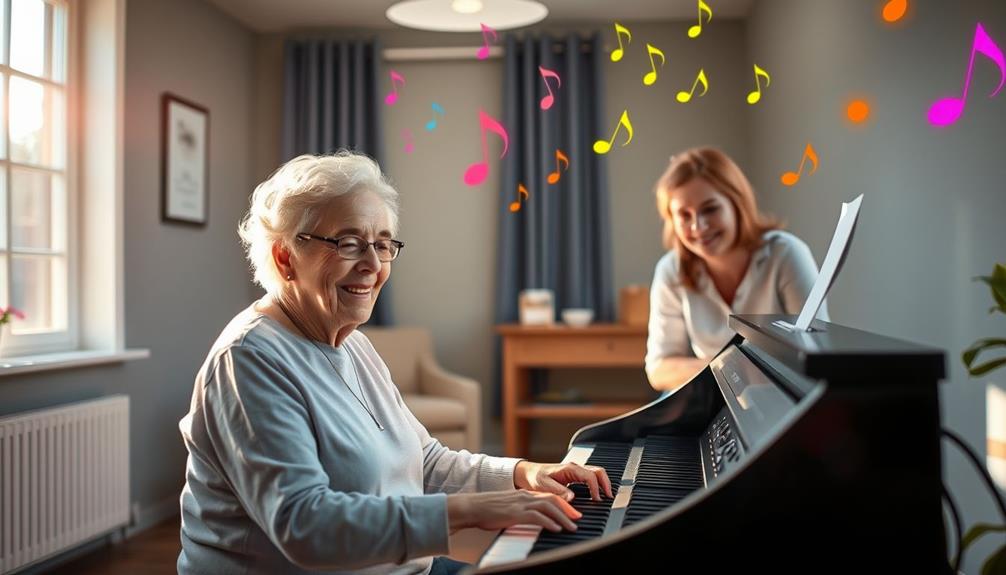
Music therapy offers profound emotional benefits for stroke patients, greatly enhancing their overall well-being. Engaging with music can considerably improve your mood and emotional state. The therapeutic use of music not only promotes relaxation but also encourages social interaction through activities that foster teamwork and cooperation, similar to the benefits of cooperative play in child development.
Here are some key emotional benefits of music therapy:
- Improved Mood: Over 70% of stroke patients report a positive change in their mood through music engagement.
- Alleviation of Depression: Listening to music stimulates brain areas linked to emotion, increasing endorphins and helping reduce feelings of depression.
- Social Connection: Participating in music therapy fosters a sense of community, which helps combat feelings of isolation and loneliness.
- Enhanced Cognitive Function: Regular engagement in music-supported therapy leads to better emotional states and improved cognitive function, which is essential for your rehabilitation process.
Through music therapy, you not only boost your emotional well-being but also motivate yourself to actively participate in your recovery.
This holistic approach enhances therapeutic outcomes, making your journey toward recovery more enjoyable and fulfilling. Embrace the benefits of music therapy and experience its transformative power in your emotional recovery.
Future Research Directions

Significant advancements in understanding music therapy's role in stroke rehabilitation are still needed. Future research should prioritize larger randomized controlled trials to bolster evidence for music therapy's efficacy. Many existing studies have small participant numbers, limiting their impact. By investigating the ideal timing and types of music interventions tailored to specific stroke populations, you could enhance therapeutic outcomes and recovery trajectories.
Moreover, establishing standardized intervention methods and outcome measurements is vital for accurately evaluating the effectiveness of music therapy in clinical settings. This will enable healthcare professionals to implement consistent practices across various rehabilitation strategies.
An exploration of the neurobiological mechanisms behind music therapy can provide deeper insights into its impact on brain plasticity and recovery processes following a stroke. Understanding how music influences brain functions may lead to more targeted and effective treatment options.
Collaborative efforts between healthcare professionals and music therapists are essential for integrating music therapy effectively. By working together, you can maximize the benefits of music therapy for stroke patients, ultimately improving their quality of life and recovery outcomes.
Emphasizing these research directions will pave the way for a more thorough approach to stroke rehabilitation.
Integrating Music Therapy in Care
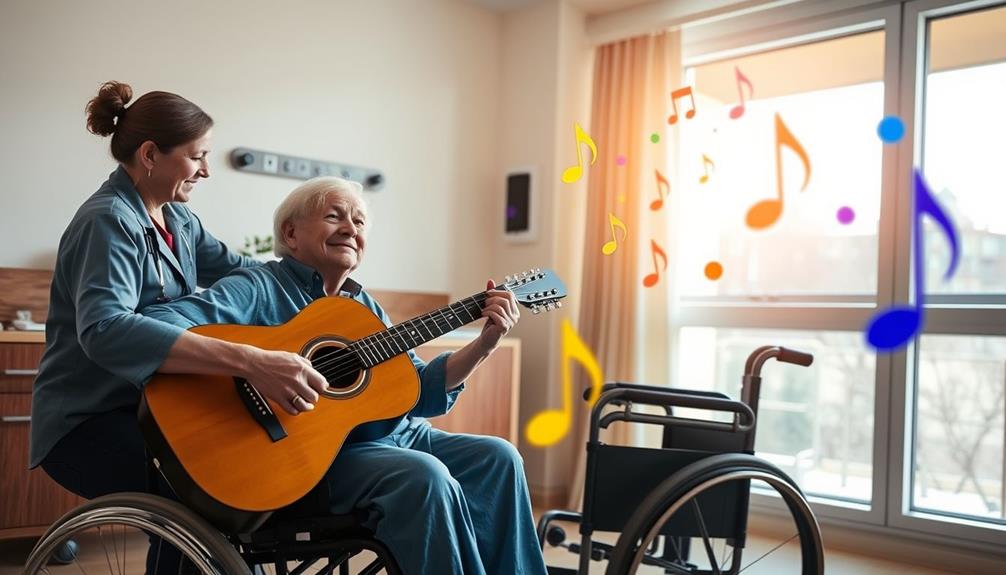
Incorporating music therapy into stroke rehabilitation programs can markedly enhance recovery outcomes. This cost-effective, patient-accepted approach not only helps improve motor function but also supports speech and language development.
Clinical evidence shows that integrating music therapy with traditional rehabilitation techniques leads to significant benefits for stroke patients. Here are four key advantages:
- Improved Motor Function: Music therapy can enhance physical rehabilitation, leading to better mobility and coordination.
- Cognitive Recovery: Engaging with music stimulates cognitive processes, aiding memory and attention in stroke survivors.
- Emotional Well-Being: Participating in music therapy fosters a positive emotional state, reducing feelings of isolation and depression.
- Community-Based Initiatives: Programs like aphasia choirs create social connections that enhance quality of life and support emotional health.
Frequently Asked Questions
How Does Music Therapy Affect Quality of Life After a Stroke?
Music therapy greatly boosts your quality of life after a stroke. It enhances mood, fosters social connections, supports cognitive recovery, and promotes neuroplasticity, helping you regain skills and improve daily functioning as you recover.
What Are Three Therapies Most People Need After Having a Stroke?
After a stroke, you'll likely need physical therapy to regain movement, speech therapy to improve communication, and cognitive rehabilitation to address memory or attention issues. These therapies are essential for restoring your independence and quality of life.
What Is the Therapeutic Role of Music Listening in Stroke Rehabilitation?
Think of music as a gentle rain nurturing your recovery. In stroke rehabilitation, listening to music boosts your mood, sharpens cognitive function, and keeps you motivated, making each step toward healing feel a bit lighter.
What Heals the Brain After a Stroke?
After a stroke, your brain heals through neuroplasticity, where neural pathways reorganize. Engaging in stimulating activities, maintaining social connections, and practicing cognitive exercises all contribute to recovery, enhancing your overall cognitive and emotional well-being.
Conclusion
As you explore the remarkable benefits of music therapy for stroke patients, you might find yourself wondering how this creative approach can transform lives. Imagine a world where melodies not only soothe the soul but also aid in recovery. The journey doesn't end here; ongoing research promises even more breakthroughs on the horizon. By integrating music therapy into rehabilitation, you can witness the incredible potential that lies in the harmony of healing—what discoveries await just around the corner?

